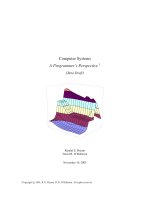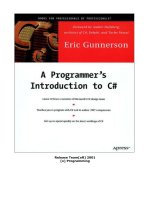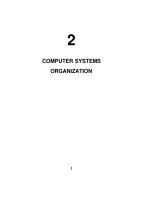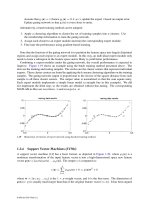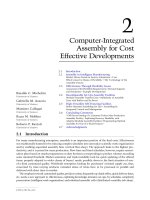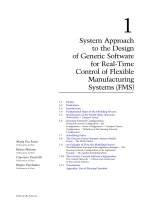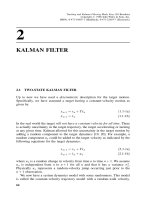Tài liệu Computer Systems A Programmer’s Perspective P2 docx
Bạn đang xem bản rút gọn của tài liệu. Xem và tải ngay bản đầy đủ của tài liệu tại đây (207.03 KB, 20 trang )
1.7. THE OPERATING SYSTEM MANAGES THE HARDWARE
11
every computer system are organized as the memory hierarchy shown in Figure 1.9. As we move from the
registers
on-chip L1
cache (SRAM)
main memory
(DRAM)
local secondary storage
(local disks)
Larger,
slower,
and
cheaper
storage
devices
remote secondary storage
(distributed file systems, Web servers)
Local disks hold files
retrieved from disks
on remote network
servers.
Main memory holds disk
blocks retrieved from local
disks.
L2 cache holds cache lines
retrieved from memory.
CPU registers hold words
retrieved from cache
memory.
off-chip L2
cache (SRAM)
L1 cache holds cache lines
retrieved from memory.
L0:
L1:
L2:
L3:
L4:
L5:
Figure 1.9: The memory hierarchy.
top of the hierarchy to the bottom, the devices become slower, larger, and less costly per byte. The register
file occupies the top level in the hierarchy, which is known as level 0 or L0. The L1 cache occupies level 1
(hence the term L1). The L2 cache occupies level 2. Main memory occupies level 3, and so on.
The main idea of a memory hierarchy is that storage at one level serves as a cache for storage at the next
lower level. Thus, the register file is a cache for the L1 cache, which is a cache for the L2 cache, which is a
cache for the main memory, which is a cache for the disk. On some networked system with distributed file
systems, the local disk serves as a cache for data stored on the disks of other systems.
Just as programmers can exploit knowledge of the L1 and L2 caches to improve performance, programmers
can exploit their understanding of the entire memory hierarchy. Chapter 6 will have much more to say about
this.
1.7 The Operating System Manages the Hardware
Back to our hello example. When the shell loaded and ran the hello program, and when the hello
program printed its message, neither program accessed the keyboard, display, disk, or main memory directly.
Rather, they relied on the services provided by the operating system. We can think of the operating system
as a layer of software interposed between the application program and the hardware, as shown in Figure 1.10.
All attempts by an application program to manipulate the hardware must go through the operating system.
The operating system has two primary purposes: (1) To protect the hardware from misuse by runaway
applications, and (2) To provide applications with simple and uniform mechanisms for manipulating com-
plicated and often wildly different low-level hardware devices. The operating system achieves both goals
12
CHAPTER 1. INTRODUCTION
application programs
processor main memory I/O devices
operating system
software
hardware
Figure 1.10: Layered view of a computer system.
via the fundamental abstractions shown in Figure 1.11: processes, virtual memory,andfiles. As this figure
processor main memory I/O devices
processes
files
virtual memory
Figure 1.11: Abstractions provided by an operating system.
suggests, files are abstractions for I/O devices. Virtual memory is an abstraction for both the main memory
and disk I/O devices. And processes are abstractions for the processor, main memory, and I/O devices. We
will discuss each in turn.
Aside: Unix and Posix.
The 1960s was an era of huge, complex operating systems, such as IBM’s OS/360 and Honeywell’s Multics systems.
While OS/360 was one of the most successful software projects in history, Multics dragged on for years and never
achieved wide-scale use. Bell Laboratories was an original partner in the Multics project, but dropped out in 1969
because of concern over the complexity of the project and the lack of progress. In reaction to their unpleasant
Multics experience, a group of Bell Labs researchers — Ken Thompson, Dennis Ritchie, Doug McIlroy, and Joe
Ossanna — began work in 1969 on a simpler operating system for a DEC PDP-7 computer, written entirely in
machine language. Many of the ideas in the new system, such as the hierarchical file system and the notion of a
shell as a user-level process, were borrowed from Multics, but implemented in a smaller, simpler package. In 1970,
Brian Kernighan dubbed the new system “Unix” as a pun on the complexity of “Multics.” The kernel was rewritten
in C in 1973, and Unix was announced to the outside world in 1974 [61].
Because Bell Labs made the source code available to schools with generous terms, Unix developed a large following
at universities. The most influential work was done at the University of California at Berkeley in the late 1970s and
early 1980s, with Berkeley researchers adding virtual memory and the Internet protocols in a series of releases called
Unix 4.xBSD (Berkeley Software Distribution). Concurrently, Bell Labs was releasing their own versions, which
become known as System V Unix. Versions from other vendors, such as the Sun Microsystems Solaris system, were
derived from these original BSD and System V versions.
Trouble arose in the mid 1980s as Unix vendors tried to differentiate themselves by adding new and often incom-
patible features. To combat this trend, IEEE (Institute for Electrical and Electronics Engineers) sponsored an effort
to standardize Unix, later dubbed “Posix” by Richard Stallman. The result was a family of standards, known as
the Posix standards, that cover such issues as the C language interface for Unix system calls, shell programs and
utilities, threads, and network programming. As more systems comply more fully with the Posix standards, the
differences between Unix version are gradually disappearing. End Aside.
1.7. THE OPERATING SYSTEM MANAGES THE HARDWARE
13
1.7.1 Processes
When a program such as hello runs on a modern system, the operating system provides the illusion that
the program is the only one running on the system. The program appears to have exclusive use of both the
processor, main memory, and I/O devices. The processor appears to execute the instructions in the program,
one after the other, without interruption. And the code and data of the program appear to be the only objects
in the system’s memory. These illusions are provided by the notion of a process, one of the most important
and successful ideas in computer science.
A process is the operating system’s abstraction for a running program. Multiple processes can run concur-
rently on the same system, and each process appears to have exclusive use of the hardware. By concurrently,
we mean that the instructions of one process are interleaved with the instructions of another process. The
operating system performs this interleaving with a mechanism known as context switching.
The operating system keeps track of all the state information that the process needs in order to run. This
state, which is known as the context, includes information such as the current values of the PC, the register
file, and the contents of main memory. At any point in time, exactly one process is running on the system.
When the operating system decides to transfer control from the current process to a some new process, it
performs a context switch by saving the context of the current process, restoring the context of the new
process, and then passing control to the new process. The new process picks up exactly where it left off.
Figure 1.12 shows the basic idea for our example hello scenario.
shell
process
hello
process
application code
Time
context
switch
context
switch
OS code
application code
OS code
application code
Figure 1.12: Process context switching.
There are two concurrent processes in our example scenario: the shell process and the hello process.
Initially, the shell process is running alone, waiting for input on the command line. When we ask it to run
the hello program, the shell carries out our request by invoking a special function known as a system
call that pass control to the operating system. The operating system saves the shell’s context, creates a new
hello process and its context, and then passes control to the new hello process. After hello terminates,
the operating system restores the context of the shell process and passes control back to it, where it waits
for the next command line input.
Implementing the process abstraction requires close cooperation between both the low-level hardware and
the operating system software. We will explore how this works, and how applications can create and control
their own processes, in Chapter 8.
One of the implications of the process abstraction is that by interleaving different processes, it distorts
14
CHAPTER 1. INTRODUCTION
the notion of time, making it difficult for programmers to obtain accurate and repeatable measurements of
running time. Chapter 9 discusses the various notions of time in a modern system and describes techniques
for obtaining accurate measurements.
1.7.2 Threads
Although we normally think of a process as having a single control flow, in modern system a process can
actually consist of multiple execution units, called threads, each running in the context of the process and
sharing the same code and global data.
Threads are an increasingly important programming model because of the requirement for concurrency in
network servers, because it is easier to share data between multiple threads than between multiple pro-
cesses, and because threads are typically more efficient than processes. We will learn the basic concepts of
threaded programs in Chapter 11, and we will learn how to build concurrent network servers with threads in
Chapter 12.
1.7.3 Virtual Memory
Virtual memory is an abstraction that provides each process with the illusion that it has exclusive use of the
main memory. Each process has the same uniform view of memory, which is known as its virtual address
space. The virtual address space for Linux processes is shown in Figure 1.13 (Other Unix systems use a
similar layout). In Linux, the topmost 1/4 of the address space is reserved for code and data in the operating
system that is common to all processes. The bottommost 3/4 of the address space holds the code and data
defined by the user’s process. Note that addresses in the figure increase from bottom to the top.
The virtual address space seen by each process consists of a number of well-defined areas, each with a
specific purpose. We will learn more about these areas later in the book, but it will be helpful to look briefly
at each, starting with the lowest addresses and working our way up:
Program code and data. Code begins at the same fixed address, followed by data locations that
correspond to global C variables. The code and data areas are initialized directly from the contents of
an executable object file, in our case the hello executable. We will learn more about this part of the
address space when we study linking and loading in Chapter 7.
Heap. The code and data areas are followed immediately by the run-time heap. Unlike the code and
data areas, which are fixed in size once the process begins running, the heap expands and contracts
dynamically at runtime as a result of calls to C standard library routines such as malloc and free.
We will study heaps in detail when we learn about managing virtual memory in Chapter 10.
Shared libraries. Near the middle of the address space is an area that holds the code and data for
shared libraries such as the C standard library and the math library. The notion of a shared library
is a powerful, but somewhat difficult concept. We will learn how they work when we study dynamic
linking in Chapter 7.
Stack. At the top of the user’s virtual address space is the user stack that the compiler uses to im-
plement function calls. Like the heap, the user stack expands and contracts dynamically during the
1.7. THE OPERATING SYSTEM MANAGES THE HARDWARE
15
kernel virtual memory
memory mapped region for
shared libraries
run-time heap
(created at runtime by malloc)
user stack
(created at runtime)
unused
0
memory
invisible to
user code
0xc0000000
0x08048000
0x40000000
read/write data
read-only code and data
loaded from the
hello
executable file
printf()
function
0xffffffff
Figure 1.13: Linux process virtual address space.
execution of the program. In particular, each time we call a function, the stack grows. Each time we
return from a function, it contracts. We will learn how the compiler uses the stack in Chapter 3.
Kernel virtual memory. The kernel is the part of the operating system that is always resident in
memory. The top 1/4 of the address space is reserved for the kernel. Application programs are not
allowed to read or write the contents of this area or to directly call functions defined in the kernel
code.
For virtual memory to work, a sophisticated interaction is required between the hardware and the operating
system software, including a hardware translation of every address generated by the processor. The basic
idea is to store the contents of a process’s virtual memory on disk, and then use the main memory as a cache
for the disk. Chapter 10 explains how this works and why it is so important to the operation of modern
systems.
1.7.4 Files
A Unix file is a sequence of bytes, nothing more and nothing less. Every I/O device, including disks,
keyboards, displays, and even networks, is modeled as a file. All input and output in the system is performed
by reading and writing files, using a set of operating system functions known as system calls.
This simple and elegant notion of a file is nonetheless very powerful because it provides applications with
a uniform view of all of the varied I/O devices that might be contained in the system. For example, appli-
cation programmers who manipulate the contents of a disk file are blissfully unaware of the specific disk
technology. Further, the same program will run on different systems that use different disk technologies.
16
CHAPTER 1. INTRODUCTION
Aside: The Linux project.
In August, 1991, a Finnish graduate student named Linus Torvalds made a modest posting announcing a new
Unix-like operating system kernel:
From: (Linus Benedict Torvalds)
Newsgroups: comp.os.minix
Subject: What would you like to see most in minix?
Summary: small poll for my new operating system
Date: 25 Aug 91 20:57:08 GMT
Hello everybody out there using minix -
I’m doing a (free) operating system (just a hobby, won’t be big and
professional like gnu) for 386(486) AT clones. This has been brewing
since April, and is starting to get ready. I’d like any feedback on
things people like/dislike in minix, as my OS resembles it somewhat
(same physical layout of the file-system (due to practical reasons)
among other things).
I’ve currently ported bash(1.08) and gcc(1.40), and things seem to work.
This implies that I’ll get something practical within a few months, and
I’d like to know what features most people would want. Any suggestions
are welcome, but I won’t promise I’ll implement them :-)
Linus ()
The rest, as they say, is history. Linux has evolved into a technical and cultural phenomenon. By combining forces
with the GNU project, the Linux project has developed a complete, Posix-compliant version of the Unix operating
system, including the kernel and all of the supporting infrastructure. Linux is available on a wide array of computers,
from hand-held devices to mainframe computers. And it has renewed interest in the idea of open source software
pioneered by the GNU project in the 1980s. We believe that a number of factors have contributed to the popularity
of GNU/Linux systems:
Linux is relatively small. With about one million ( ) lines of source code, the Linux kernel is significantly
smaller than comparable commercial operating systems. We recently saw a version of Linux running on a
wristwatch!
Linux is robust. The code development model for Linux is unique, and has resulted in a surprisingly robust
system. The model consists of (1) a large set of programmers distributed around the world who update their
local copies of the kernel source code, and (2) a system integrator (Linus) who decides which of these updates
will become part of the official release. The model works because quality control is maintained by a talented
programmer who understands everything about the system. It also results in quicker bug fixes because the
pool of distributed programmers is so large.
Linux is portable. Since Linux and the GNU tools are written in C, Linux can be ported to new systems
without extensive code modifications.
Linux is open-source. Linux is open source, which means that it can be down-loaded, modified, repackaged,
and redistributed without restriction, gratis or for a fee, as long as the new sources are included with the
distribution. This is different from other Unix versions, which are encumbered with software licenses that
restrict software redistributions that might add value and make the system easier to use and install.
End Aside.
1.8 Systems Communicate With Other Systems Using Networks
Up to this point in our tour of systems, we have treated a system as an isolated collection of hardware
and software. In practice, modern systems are often linked to other systems by networks. From the point of
1.8. SYSTEMS COMMUNICATE WITH OTHER SYSTEMS USING NETWORKS
17
view of an individual system, the network can be viewed as just another I/O device, as shown in Figure 1.14.
When the system copies a sequence of bytes from main memory to the network adapter, the data flows across
main
memory
I/O
bridge
memory interface
ALU
register file
CPU chip
system bus
memory bus
disk
controller
graphics
adapter
USB
controller
mouse keyboard monitor
disk
I/O bus
Expansion slots
network
adapter
network
PC
Figure 1.14: A network is another I/O device.
the network to another machine, instead of say, to a local disk drive. Similarly, the system can read data sent
from other machines and copy this data to its main memory.
With the advent of global networks such as the Internet, copying information from one machine to another
has become one of the most important uses of computer systems. For example, applications such as email,
instant messaging, the World Wide Web, FTP, and telnet are all based on the ability to copy information
over a network.
Returning to our hello example, we could use the familiar telnet application to run hello on a remote
machine. Suppose we use a telnet client running on our local machine to connect to a telnet server on
a remote machine. After we log in to the remote machine and run a shell, the remote shell is waiting to
receive an input command. From this point, running the hello program remotely involves the five basic
steps shown in Figure 1.15.
local
telnet
client
remote
telnet
server
2. client sends "hello"
string to telnet server
3. server sends "hello"
string to the shell, which
runs the hello program,
and sends the output
to the telnet server
4. telnet server sends
"hello, world\n" string
to client
5. client prints
"hello, world\n"
string on display
1. user types
"hello" at the
keyboard
Figure 1.15: Using telnet to run hello remotely over a network.
After we type the ”hello” string to the telnet client and hit the enter key, the client sends the string to
18
CHAPTER 1. INTRODUCTION
the telnet server. After the telnet server receives the string from the network, it passes it along to the remote
shell program. Next, the remote shell runs the hello program, and passes the output line back to the telnet
server. Finally, the telnet server forwards the output string across the network to the telnet client, which
prints the output string on our local terminal.
This type of exchange between clients and servers is typical of all network applications. In Chapter 12 we
will learn how to build network applications, and apply this knowledge to build a simple Web server.
1.9 Summary
This concludes our initial whirlwind tour of systems. An important idea to take away from this discussion is
that a system is more than just hardware. It is a collection of intertwined hardware and software components
that must work cooperate in order to achieve the ultimate goal of running application programs. The rest of
this book will expand on this theme.
Bibliographic Notes
Ritchie has written interesting first-hand accounts of the early days of C and Unix [59, 60]. Ritchie and
Thompson presented the first published account of Unix [61]. Silberschatz and Gavin [66] provide a compre-
hensive history of the different flavors of Unix. The GNU (www.gnu.org) and Linux (www.linux.org)
Web pages have loads of current and historical information. Unfortunately, the Posix standards are not avail-
able online. They must be ordered for a fee from IEEE (standards.ieee.org).
Part I
Program Structure and Execution
19
Chapter 2
Representing and Manipulating
Information
Modern computers store and process information represented as two-valued signals. These lowly binary
digits, or bits, form the basis of the digital revolution. The familiar decimal, or base-10, representation has
been in use for over 1000 years, having been developed in India, improved by Arab mathematicians in the
12th century, and brought to the West in the 13th century by the Italian mathematician Leonardo Pisano,
better known as Fibonacci. Using decimal notation is natural for ten-fingered humans, but binary values
work better when building machines that store and process information. Two-valued signals can readily
be represented, stored, and transmitted, for example, as the presence or absence of a hole in a punched
card, as a high or low voltage on a wire, or as a magnetic domain oriented clockwise or counterclockwise.
The electronic circuitry for storing and performing computations on two-valued signals is very simple and
reliable, enabling manufacturers to integrate millions of such circuits on a single silicon chip.
In isolation, a single bit is not very useful. When we group bits together and apply some interpretation that
gives meaning to the different possible bit patterns, however, we can represent the elements of any finite set.
For example, using a binary number system, we can use groups of bits to encode nonnegative numbers. By
using a standard character code, we can encode the letters and symbols in a document. We cover both of
these encodings in this chapter, as well as encodings to represent negative numbers and to approximate real
numbers.
We consider the three most important encodings of numbers. Unsigned encodings are based on traditional
binary notation, representing numbers greater than or equal to 0. Two’s complement encodings are the most
common way to represent signed integers, that is, numbers that may be either positive or negative. Floating-
point encodings are a base-two version of scientific notation for representing real numbers. Computers
implement arithmetic operations such as addition and multiplication, with these different representations
similar to the corresponding operations on integers and real numbers.
Computer representations use a limited number of bits to encode a number, and hence some operations can
overflow when the results are too large to be represented. This can lead to some surprising results. For
example, on most of today’s computers, computing the expression
200 * 300 * 400 * 500
21
22
CHAPTER 2. REPRESENTING AND MANIPULATING INFORMATION
yields 884,901,888. This runs counter to the properties of integer arithmetic—computing the product of a
set of positive numbers has yielded a negative result.
On the other hand, integer computer arithmetic satisfies many of the familiar properties of true integer arith-
metic. For example, multiplication is associative and commutative, so that computing all of the following C
expressions yields
884,901,888:
(500 * 400) * (300 * 200)
((500 * 400) * 300) * 200
((200 * 500) * 300) * 400
400 * (200 * (300 * 500))
The computer might not generate the expected result, but at least it is consistent!
Floating point arithmetic has altogether different mathematical properties. The product of a set of positive
numbers will always be positive, although overflow will yield the special value
. On the other hand,
floating point arithmetic is not associative due to the finite precision of the representation. For example,
the C expression (3.14+1e20)-1e20 will evaluate to 0.0 on most machines, while 3.14+(1e20-
1e20) will evaluate to 3.14.
By studying the actual number representations, we can understand the ranges of values that can be repre-
sented and the properties of the different arithmetic operations. This understanding is critical to writing
programs that work correctly over the full range of numeric values and that are portable across different
combinations of machine, operating system, and compiler. Our treatment of this material is very mathe-
matical. We start with the basic definitions of the encodings and then derive such properties as the range of
representable numbers, their bit-level representations, and the properties of the arithmetic operations. We
believe it is important to examine this material from such an abstract viewpoint, because programmers need
to have a solid understanding of how computer arithmetic relates to the more familiar integer and real arith-
metic. Although it may appear intimidating, the mathematical treatment requires just an understanding of
basic algebra. We recommend working the practice problems as a way to solidify the connection between
the formal treatment and some real-life examples.
We derive several ways to perform arithmetic operations by directly manipulating the bit-level representa-
tions of numbers. Understanding these techniques will be important for understanding the machine-level
code generated when compiling arithmetic expressions.
The C++ programming language is built upon C, using the exact same numeric representations and opera-
tions. Everything said in this chapter about C also holds for C++. The Java language definition, on the other
hand, created a new set of standards for numeric representations and operations. Whereas the C standard is
designed to allow a wide range of implementations, the Java standard is quite specific on the formats and
encodings of data. We highlight the representations and operations supported by Java at several places in
the chapter.
2.1 Information Storage
Rather than accessing individual bits in a memory, most computers use blocks of eight bits, or bytes as
the smallest addressable unit of memory. A machine-level program views memory as a very large array of
2.1. INFORMATION STORAGE
23
Hex digit 0 1 2 3 4 5 6 7
Decimal Value 0 1 2 3 4 5 6 7
Binary Value 0000 0001 0010 0011 0100 0101 0110 0111
Hex digit 8 9 A B C D E F
Decimal Value 8 9 10 11 12 13 14 15
Binary Value 1000 1001 1010 1011 1100 1101 1110 1111
Figure 2.1: Hexadecimal Notation Each Hex digit encodes one of 16 values.
bytes, referred to as virtual memory. Every byte of memory is identified by a unique number, known as
its address, and the set of all possible addresses is known as the virtual address space. As indicated by its
name, this virtual address space is just a conceptual image presented to the machine-level program. The
actual implementation (presented in Chapter 10) uses a combination of random-access memory (RAM),
disk storage, special hardware, and operating system software to provide the program with what appears to
be a monolithic byte array.
One task of a compiler and the run-time system is to subdivide this memory space into more manageable
units to store the different program objects, that is, program data, instructions, and control information.
Various mechanisms are used to allocate and manage the storage for different parts of the program. This
management is all performed within the virtual address space. For example, the value of a pointer in C—
whether it points to an integer, a structure, or some other program unit—is the virtual address of the first
byte of some block of storage. The C compiler also associates type information with each pointer, so that it
can generate different machine-level code to access the value stored at the location designated by the pointer
depending on the type of that value. Although the C compiler maintains this type information, the actual
machine-level program it generates has no information about data types. It simply treats each program
object as a block of bytes, and the program itself as a sequence of bytes.
New to C?
Pointers are a central feature of C. They provide the mechanism for referencing elements of data structures,
including arrays. Just like a variable, a pointer has two aspects: its value and its type. The value indicates the
location of some object, while its type indicates what kind (e.g., integer or floating-point number) of object is stored
at that location. End
2.1.1 Hexadecimal Notation
A single byte consists of eight bits. In binary notation, its value ranges from to .
When viewed as a decimal integer, its value ranges from
to . Neither notation is very convenient for
describing bit patterns. Binary notation is too verbose, while with decimal notation, it is tedious to convert
to and from bit patterns. Instead, we write bit patterns as base-16, or hexadecimal numbers. Hexadecimal
(or simply “Hex”) uses digits ‘0’ through ‘9’, along with characters ‘A’ through ‘F’ to represent 16 possible
values. Figure 2.1 shows the decimal and binary values associated with the 16 hexadecimal digits. Written
in hexadecimal, the value of a single byte can range from 00
to FF .
In C, numeric constants starting with 0x or 0X are interpreted as being in hexadecimal. The characters
24
CHAPTER 2. REPRESENTING AND MANIPULATING INFORMATION
‘A’ through ‘F’ may be written in either upper or lower case. For example, we could write the number
FA1D37B
as 0xFA1D37B,as0xfa1d37b, or even mixing upper and lower case, e.g., 0xFa1D37b.
We will use the C notation for representing hexadecimal values in this book.
A common task in working with machine-level programs is to manually convert between decimal, binary,
and hexadecimal representations of bit patterns. A starting point is to be able to convert, in both directions,
between a single hexadecimal digit and a four-bit binary pattern. This can always be done by referring
to a chart such as that shown in Figure 2.1. When doing the conversion manually, one simple trick is to
memorize the decimal equivalents of hex digits A, C,andF. The hex values B, D,andEcan be translated to
decimal by computing their values relative to the first three.
Practice Problem 2.1:
Fill in the missing entries in the following figure, giving the decimal, binary, and hexadecimal values of
different byte patterns.
Decimal Binary Hexadecimal
0 00000000 00
55
136
243
01010010
10101100
11100111
A7
3E
BC
Aside: Converting between decimal and hexadecimal.
For converting larger values between decimal and hexadecimal, it is best to let a computer or calculator do the work.
For example, the following script in the Perl language converts a list of numbers from decimal to hexadecimal:
bin/d2h
1 #!/usr/local/bin/perl
2 # Convert list of decimal numbers into hex
3 for ($i = 0; $i < @ARGV; $i++)
4 printf("%d = 0x%x\n", $ARGV[$i], $ARGV[$i]);
5
bin/d2h
Once this file has been set to be executable, the command:
unix>
./d2h 100 500 751
will yield output:
2.1. INFORMATION STORAGE
25
100 = 0x64
500 = 0x1f4
751 = 0x2ef
Similarly, the following script converts from hexadecimal to decimal:
bin/h2d
1 #!/usr/local/bin/perl
2 # Convert list of decimal numbers into hex
3 for ($i = 0; $i < @ARGV; $i++)
4 $val = hex($ARGV[$i]);
5 printf("0x%x = %d\n", $val, $val);
6
bin/h2d
End Aside.
2.1.2 Words
Every computer has a word size, indicating the nominal size of integer and pointer data. Since a virtual
address is encoded by such a word, the most important system parameter determined by the word size is
the maximum size of the virtual address space. That is, for a machine with an
-bit word size, the virtual
addresses can range from
to , giving the program access to at most bytes.
Most computers today have a 32-bit word size. This limits the virtual address space to 4 gigabytes (written
4 GB), that is, just over
bytes. Although this is ample space for most applications, we have
reached the point where many large-scale scientific and database applications require larger amounts of
storage. Consequently, high-end machines with 64-bit word sizes are becoming increasingly commonplace
as storage costs decrease.
2.1.3 Data Sizes
Computers and compilers support multiple data formats using different ways to encode data, such as in-
tegers and floating point, as well as different lengths. For example, many machines have instructions for
manipulating single bytes, as well as integers represented as two, four, and eight-byte quantities. They also
support floating-point numbers represented as four and eight-byte quantities.
The C language supports multiple data formats for both integer and floating-point data. The C data type
char represents a single byte. Although the name “char” derives from the fact that it is used to store
a single character in a text string, it can also be used to store integer values. The C data type int can
also be prefixed by the qualifiers long and short, providing integer representations of various sizes.
Figure 2.2 shows the number of bytes allocated for various C data types. The exact number depends on
both the machine and the compiler. We show two representative cases: a typical 32-bit machine, and the
Compaq Alpha architecture, a 64-bit machine targeting high end applications. Most 32-bit machines use
the allocations indicated as “typical.” Observe that “short” integers have two-byte allocations, while an
unqualified int is 4 bytes. A “long” integer uses the full word size of the machine.
26
CHAPTER 2. REPRESENTING AND MANIPULATING INFORMATION
C Declaration Typical 32-bit Compaq Alpha
char 1 1
short int 2 2
int 4 4
long int 4 8
char * 4 8
float 4 4
double 8 8
Figure 2.2: Sizes (in Bytes) of C Numeric Data Types. The number of bytes allocated varies with machine
and compiler.
Figure 2.2 also shows that a pointer (e.g., a variable declared as being of type “char *”) uses the full word
size of the machine. Most machines also support two different floating-point formats: single precision,
declared in C as float, and double precision, declared in C as double. These formats use four and eight
bytes, respectively.
New to C?
For any data type
, the declaration
*p;
indicates that p is a pointer variable, pointing to an object of type . For example
char *p;
is the declaration of a pointer to an object of type char. End
Programmers should strive to make their programs portable across different machines and compilers. One
aspect of portability is to make the program insensitive to the exact sizes of the different data types. The
C standard sets lower bounds on the numeric ranges of the different data types, as will be covered later,
but there are no upper bounds. Since 32-bit machines have been the standard for the last 20 years, many
programs have been written assuming the allocations listed as “typical 32-bit” in Figure 2.2. Given the
increasing prominence of 64-bit machines in the near future, many hidden word size dependencies will
show up as bugs in migrating these programs to new machines. For example, many programmers assume
that a program object declared as type int can be used to store a pointer. This works fine for most 32-bit
machines but leads to problems on an Alpha.
2.1.4 Addressing and Byte Ordering
For program objects that span multiple bytes, we must establish two conventions: what will be the address
of the object, and how will we order the bytes in memory. In virtually all machines, a multibyte object is
stored as a contiguous sequence of bytes, with the address of the object given by the smallest address of the
2.1. INFORMATION STORAGE
27
bytes used. For example, suppose a variable x of type int has address 0x100, that is, the value of the
address expression &x is 0x100. Then the four bytes of x would be stored in memory locations 0x100,
0x101, 0x102,and0x103.
For ordering the bytes representing an object, there are two common conventions. Consider a
-bit integer
having a bit representation
,where is the most significant bit, and is the
least. Assuming
is a multiple of eight, these bits can be grouped as bytes, with the most significant byte
having bits
, the least significant byte having bits , and the other
bytes having bits from the middle. Some machines choose to store the object in memory ordered from least
significant byte to most, while other machines store them from most to least. The former convention—where
the least significant byte comes first—is referred to as little endian. This convention is followed by most
machines from the former Digital Equipment Corporation (now part of Compaq Corporation), as well as by
Intel. The latter convention—where the most significant byte comes first—is referred to as big endian.This
convention is followed by most machines from IBM, Motorola, and Sun Microsystems. Note that we said
“most.” The conventions do not split precisely along corporate boundaries. For example, personal computers
manufactured by IBM use Intel-compatible processors and hence are little endian. Many microprocessor
chips, including Alpha and the PowerPC by Motorola can be run in either mode, with the byte ordering
convention determined when the chip is powered up.
Continuing our earlier example, suppose the variable x of type int and at address 0x100 has a hexadecimal
value of 0x01234567. The ordering of the bytes within the address range 0x100 through 0x103 depends
on the type of machine:
Big endian
0x100 0x101 0x102 0x103
01 23 45 67
Little endian
0x100 0x101 0x102 0x103
67 45 23 01
Note that in the word 0x01234567 the high-order byte has hexadecimal value 0x01, while the low-order
byte has value 0x67.
People get surprisingly emotional about which byte ordering is the proper one. In fact, the terms “little
endian” and “big endian” come from the book Gulliver’s Travels by Jonathan Swift, where two warring
factions could not agree by which end a soft-boiled egg should be opened—the little end or the big. Just like
the egg issue, there is no technological reason to choose one byte ordering convention over the other, and
hence the arguments degenerate into bickering about sociopolitical issues. As long as one of the conventions
is selected and adhered to consistently, the choice is arbitrary.
Aside: Origin of “Endian.”
Here is how Jonathan Swift, writing in 1726, described the history of the controversy between big and little endians:
thetwogreatempiresofLilliput and Blefuscu. Which two mighty powers have, as I was going
to tell you, been engaged in a most obstinate war for six-and-thirty moons past. It began upon the
following occasion. It is allowed on all hands, that the primitive way of breaking eggs, before we eat
28
CHAPTER 2. REPRESENTING AND MANIPULATING INFORMATION
them, was upon the larger end; but his present majesty’s grandfather, while he was a boy, going to eat an
egg, and breaking it according to the ancient practice, happened to cut one of his fingers. Whereupon
the emperor his father published an edict, commanding all his subjects, upon great penalties, to break
the smaller end of their eggs. The people so highly resented this law, that our histories tell us, there have
been six rebellions raised on that account; wherein one emperor lost his life, and another his crown.
These civil commotions were constantly fomented by the monarchs of Blefuscu; and when they were
quelled, the exiles always fled for refuge to that empire. It is computed that eleven thousand persons
have at several times suffered death, rather than submit to break their eggs at the smaller end. Many
hundred large volumes have been published upon this controversy: but the books of the Big-endians
have been long forbidden, and the whole party rendered incapable by law of holding employments.
In his day, Swift was satirizing the continued conflicts between England (Lilliput) and France (Blefuscu). Danny
Cohen, an early pioneer in networking protocols, first applied these terms to refer to byte ordering [16], and the
terminology has been widely adopted. End Aside.
For most application programmers, the byte orderings used by their machines are totally invisible. Programs
compiled for either class of machine give identical results. At times, however, byte ordering becomes an
issue. The first is when binary data is communicated over a network between different machines. A common
problem is for data produced by a little-endian machine to be sent to a big-endian machine, or vice-versa,
leading to the bytes within the words being in reverse order for the receiving program. To avoid such
problems, code written for networking applications must follow established conventions for byte ordering
to make sure the sending machine converts its internal representation to the network standard, while the
receiving machine converts the network standard to its internal representation. We will see examples of
these conversions in Chapter 12.
A second case is when programs are written that circumvent the normal type system. In the C language, this
can be done using a cast to allow an object to be referenced according to a different data type from which
it was created. Such coding tricks are strongly discouraged for most application programming, but they can
be quite useful and even necessary for system-level programming.
Figure 2.3 shows C code that uses casting to access and print the byte representations of different program
objects. We use typedef to define data type byte_pointer as a pointer to an object of type “un-
signed char.” Such a byte pointer references a sequence of bytes where each byte is considered to be a
nonnegative integer. The first routine show_bytes is given the address of a sequence of bytes, indicated
by a byte pointer, and a byte count. It prints the individual bytes in hexadecimal. The C formatting directive
“%.2x” indicates that an integer should be printed in hexadecimal with at least two digits.
New to C?
The typedef declaration in C provides a way of giving a name to a data type. This can be a great help in improving
code readability, since deeply nested type declarations can be difficult to decipher.
The syntax for typedef is exactly like that of declaring a variable, except that it uses a type name rather than a
variable name. Thus, the declaration of byte_pointer in Figure 2.3 has the same form as would the declaration
of a variable to type “unsigned char.”
For example, the declaration:
typedef int *int_pointer;
int_pointer ip;
defines type “int_pointer” to be a pointer to an int, and declares a variable ip of this type. Alternatively, we
could declare this variable directly as:
2.1. INFORMATION STORAGE
29
code/data/show-bytes.c
1 #include <stdio.h>
2
3
typedef unsigned char *byte_pointer;
4
5
void show_bytes(byte_pointer start, int len)
6 {
7 int i;
8 for (i = 0; i < len; i++)
9 printf(" %.2x", start[i]);
10 printf("\n");
11 }
12
13
void show_int(int x)
14 {
15 show_bytes((byte_pointer) &x, sizeof(int));
16 }
17
18
void show_float(float x)
19 {
20 show_bytes((byte_pointer) &x, sizeof(float));
21 }
22
23
void show_pointer(void *x)
24 {
25 show_bytes((byte_pointer) &x, sizeof(void *));
26 }
code/data/show-bytes.c
Figure 2.3: Code to Print the Byte Representation of Program Objects. This code uses casting to
circumvent the type system. Similar functions are easily defined for other data types.
30
CHAPTER 2. REPRESENTING AND MANIPULATING INFORMATION
int *ip;
End
New to C?
The printf function (along with its cousins fprintf and sprintf) provides a way to print information with
considerable control over the formatting details. The first argument is a format string, while any remaining
arguments are values to be printed. Within the formatting string, each character sequence starting with ‘%’ indicates
how to format the next argument. Typical examples include ‘%d’ to print a decimal integer and ‘%f’toprinta
floating-point number, and ‘%c’ to print a character having the character code given by the argument. End
New to C?
In function show_bytes (Figure 2.3) we see the close connection between pointers and arrays, as will be dis-
cussed in detail in Section 3.8. We see that this function has an argument start of type byte_pointer (which
has been defined to be a pointer to unsigned char,) but we see the array reference start[i] on line 9. In
C, we can use reference a pointer with array notation, and we can reference arrays with pointer notation. In this
example, the reference start[i] indicates that we want to read the byte that is i positions beyond the location
pointed to by start. End
Procedures show_int,show_float,andshow_pointer demonstrate how to use procedure show_bytes
to print the byte representations of C program objects of type int, float,andvoid *, respectively. Ob-
serve that they simply pass show_bytes a pointer &x to their argument x, casting the pointer to be of type
“unsigned char *.” This cast indicates to the compiler that the program should consider the pointer to
be to a sequence of bytes rather than to an object of the original data type. This pointer will then be to the
lowest byte address used by the object.
New to C?
In lines 15, 20, and 24 of Figure 2.3 we see uses of two operations that are unique to C and C++. The C “address of”
operator & creates a pointer. On all three lines, the expression &x creates a pointer to the location holding variable
x. The type of this pointer depends on the type of x, and hence these three pointers are of type int *, float *,
and void **, respectively. (Data type void * is a special kind of pointer with no associated type information.)
The cast operator converts from one data type to another. Thus, the cast (byte_pointer) &x indicates that
whatever type the pointer &x had before, it now is a pointer to data of type unsigned char. End
These procedures use the C operator sizeof to determine the number of bytes used by the object. In
general, the expression sizeof(
) returns the number of bytes required to store an object of type .
Using sizeof, rather than a fixed value, is one step toward writing code that is portable across different
machine types.
We ran the code shown in Figure 2.4 on several different machines, giving the results shown in Figure 2.5.
The machines used were:
Linux: Intel Pentium II running Linux.
NT: Intel Pentium II running Windows-NT.
Sun: Sun Microsystems UltraSPARC running Solaris.
Alpha: Compaq Alpha 21164 running Tru64 Unix.
